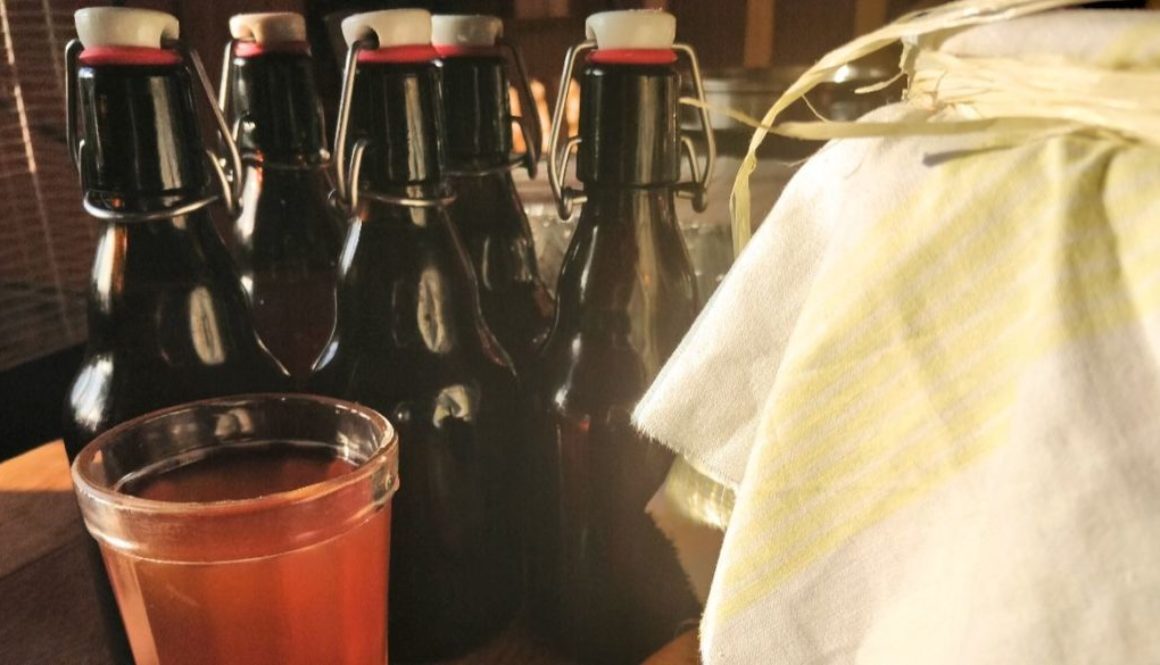Kombucha
According to Louise Avery book “Kombucha: Healthy recipes for naturally fermented tea drinks,” it is a natural carbonated fermented tea that contains a lot of probiotics, enzymes, and antioxidants. In the Comprehensive Review in „Food Science and Food Safety“ 2014, (Muthuswamy Sathishkumar and 2014) describing the origin of the kombucha, its diversity, and the experimentally proven positive health effects, including reduction of oxidative stress, promotion of general metabolism, protection of the liver, positive digestive and anti-cancer effects. Historically, Kombucha is believed to originate from North China, where it was used already during the Tsin Dynasty (220 B.C.). In year 414 doctor Kombu was treated Japanese Emperor Inkyo using kombucha drink. At the beginning of the 20th century, it reached Europe, in the 1950s spreads over the world. The kombucha is a symbiotic organism, where dozens of species of bacteria and yeast living together. Acetobacter and Gluconobacter families are common among the bacteria. The number of yeasts of families Saccharomyces, Saccharomycodes, Schizosaccharomyces, Zygosaccharomyces, Brettanomyces, Candida, Torulospora, Koleckera, Pichia, Mycotorula, and Mycoderma are described in kombucha. In fermentation, the kombucha consumes tea and added sugar. As a result of the fermentation, acetic acid, glucuronic acid, gluconic acid, fructose is formed and also residual sucrose can be found in kombucha.
Kombucha prefers green and black tea. For fermentation plenty of sugar is consumed during the preparation of this beverage, but most of the sugar will be consumed and metabolized by kombucha. If you are making the very first portion of the kombucha drink, don’t drink it because it doesn’t taste good. During the first fermentation, the kombucha has got its species composition in balance to live and ferment well. From the second batch, the beverage tastes as it should.

Preparation time: 1-1.5h preparation. 1-week fermentation, 20 min filtration
Level: Easy
Amount: 3L
Ingredients:
2-3 teaspoons of tea (green or black)
3L of water
1 glass of sugar
Accessories
3-4L glass jar
A clean piece of cloth to cover the jar and string to tie it
Funnel for pouring tea into bottles
A clean piece of cloth for filtering the kombucha
Preparation:
1. Prepare 3L of tea, add sugar, let it cool
2. Pour the tea through the cloth into the brewing container (cans)
2. Carefully lift the kombucha onto the surface of the liquid, cover with cloth and tie. Let it fermented for a 7 days
3. After 7 days, prepare a new portion of tea with sugar, let cool and sieve …
4. Put the kombucha in a plate, pour the prepared beverage through a cloth filter, rinse the jar to remove any debris that has precipitated. I never wash the jar properly. Rather, it is good if the previous brewing siblings remain in it as the starter
4. Pour fresh tea into a jar, carefully lift the kombucha onto the surface of the liquid.
5. Fill the bottles with the filtered kombucha drink. Close the bottles tight, 100% airtightness is not necessary if it is not possible. If so, opening the bottle for drinking is to understand that the beverage has been fermented further.
6. Keep the bottles in the refrigerator. Do not be afraid if there is a new small kombucha is growing up in a week or two. This shows that your kombucha feels well and is viable. It is best to drink it chilled.
Ready !!
The kombucha is like a domestic animal. It has to be taken care of and if there is a longer gap between care, the next kombucha preparation will not tastes. If you need to travel during a longer period, keep the kombucha to +4 degrees, you can keep it there for a month or more, but to get it back in fermentation, you need to get started from the beginning as described above, where the first portion is not suitable for drinking.

